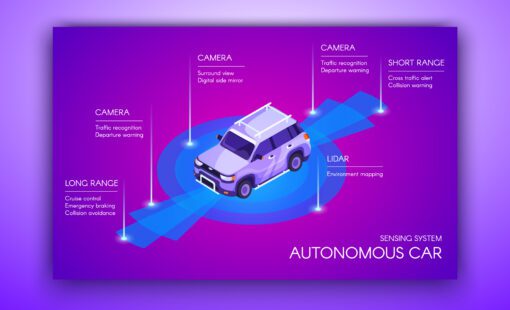Modeling a working product: the benefits are obvious
What exactly is a digital twin? It is a simulated model of an actual working product in the field, informed by sensors mounted on the product that gathers and feedback real-time, real-world operating data. By studying the digital twin under actual working conditions, companies can see the product in action, over time, when subjected to the physical environment. This allows the product development team to close the loop on its initial simulations. Engineers can make more informed choices for future designs and make their simulations even more accurate.
Even more important, digital twins enable true predictive maintenance. Instead of over-servicing or over-maintaining products to avoid costly downtime, repairs or replacement, companies can act “just in time” to address any product performance issues. They can accurately visualize exactly when and where maintenance is needed, instead of making blind guesses and safe bets.
The time and cost savings are substantial. Via digital twins, enterprises of all sizes and types can eliminate unnecessary maintenance, bring an end to product downtime, reduce repairs and minimize warranty expenses. Enabled by the rise of smart connected product technology — which allows durable, competitively priced sensors to be mounted on working products — digital twins represent an idea whose time has clearly arrived.
An ambitious vision…with practical challenges
There’s no doubt that digital twins have the potential to revolutionize the field of product maintenance and repair. Why aren’t more enterprises implementing this obvious best practice? The answer is that most businesses lack the dedicated resources to create a simulated product model, verify the model, deploy the model by connecting it to actual working products, then analyze the collected information. Because this process typically involves multiple functions and multiple technology platforms, most companies are intimidated by the practical challenges of implementing the concept of digital twins within their own operations.
Build, validate, deploy: a three-step process
Leveraging the concept of digital twins may seem daunting, but in fact, this process involves three straightforward steps: build a digital model of the product system, verify the model, then implement it by connecting it to the physical product in the field.
For businesses relying on engineering simulation to design products, the first two steps have likely already been accomplished by the product development team, as engineers iterated on their designs to achieve an optimal performance level. For companies new to simulation, a comprehensive digital twin solution would walk them through this process, led by the engineering team.
Engineers supporting the digital twin initiative would first build the three-dimensional product model, then verify and optimize its performance by applying multiple physical forces — replicating the real world in which the product system will operate. They would re-use models and data from the original product development process, saving time and money, while also forging a closer relationship between the engineering and operations teams.
In deploying the digital twin, an ideal solution would be built on an agnostic technology platform that seamlessly integrates with smart connected sensors mounted on the product— as well as third-party technology systems and tools that the organization already owns. The solution thus provides unequaled insight into the product in the form of a potentially very large number of virtual sensors that can be attached to the simulation model. Through easy-to-follow workflows, this complex process would be simplified so that many different employees in the business could be closely involved in the digital twin initiative.
With data captured by the sensors, the model would then be continuously updated as time passes and as conditions change. Insights gained from the digital twin would inform future product development efforts, while also enabling the operations function to optimize lifetime maintenance and repair for working product systems.
Finally, true predictive maintenance
Businesses have always tried to capitalize on the value of predictive maintenance, but the truth is that technology just has not existed to fulfill this vision until recently. Lacking the ability to see inside their working product systems — and analyze the real physical effects of vibration, wear and other stresses — companies have tended to hedge their bets, over-maintaining their capital assets. While cost- and time-intensive, this practice at least reduced the likelihood of unplanned downtime and unhappy customers.
The advent of digital twins solves this problem. Now companies can actually visualize and study exactly what is happening inside their most critical product systems, via a three-dimensional virtual model that is subjected to the same environmental conditions as the working product. With this ability, businesses can leverage true predictive maintenance to address performance issues only when needed, without over- or under-investing their critical resources.
Clearly, the opportunity is here for more and more enterprises to experience the benefits of digital twins. With ANSYS Twin Builder, you can do just that. Take a look at how some of our customers are harnessing the power of digital twins.
“ANSYS Twin Builder and other ANSYS products perform circuit quality pre-verification and electromagnetic interference simulations of our home appliances’ power electronics, electrical motors, and controllers. With the help of Twin Builder, we’re developing innovative products by implementing digital twins to create virtual prototypes at the component level and share IoT information among products — supporting research to boost product reliability, reduce the time to market, decrease the need for physical testing and improve product development.”
Gwigeun Park – Research fellow, LG Home Appliance & Air Solution Company
“Using ANSYS Twin Builder, Volkswagen Motorsport conducted a six-step multiphysics simulation involving electrical and thermal parameters to design and validate the battery model. . .the Twin Builder simulation of the ECM was super-fast, requiring only seconds to simulate one full drive cycle of the race car through the entire race course.”
Benjamin Ahrenholz – Head of CAE Department, Volkswagen Motorsport GmbH, Hannover, Germany
“Phoenix Contact Electronics engineers use ANSYS Twin Builder to create a digital twin to accurately predict the remaining life of each relay.”
Ralf Hoffman – Senior Consultant, Phoenix Contact Electronics GmbH





